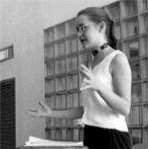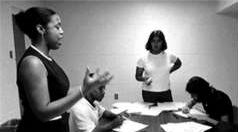|
|
||||||||||
|
|
||||||||||
|
Volume
75
Pitts bequest benefits Candler
The Once and Future Mummy Museum
|
Great Debate
A summer institute fosters forensic ability WHEN Michael Vargas arrived in Atlanta from the Bronx for the two-week Emory National Debate Institute in the summer of 1997, he knew virtually nothing about forensics. A student at Grace Dodge Vocational High School, a large public high school with resources inadequate to support a debate team, Vargas says he felt somewhat intimidated by forensic processes and practices. An average student and an avid basketball player, Vargas attended the institute because he was offered a scholarship and was intrigued by the idea of trying something new. "I wanted to challenge my mind instead of my body," he says. In spite of his fears, Vargas became one of the institute’s best debaters that summer. He and eight other students from Grace Dodge went back to New York City to form their school’s first debate team. They immediately began winning in tournaments against schools with established teams. "I learned teamwork, quick thinking, and stamina," says Vargas. "And I gained a lot of confidence. Debate is an empowerment tool." Vargas came to the Emory institute on a scholarship funded by philanthropist George Soros’ Open Society Institute, which awarded a three-year, $600,000 grant to Emory’s Barkley Forum debate program in 1997. The grant provides scholarships to middle and high school students from inner-city areas nationwide. The Open Society Institute was drawn to the Barkley Forum because of its long-standing history of support for high school debate programs in disadvantaged areas of Georgia. "We have a very strong commitment to outreach," says forum director Melissa Wade. "But we had been running our service programs on six rubber bands and a gerbil." In 1995, the Barkley Forum and the Atlanta Public Schools established the Atlanta Urban Debate League to level the disparity between suburban and urban school populations. Emory student debaters helped teach workshops and judge tournaments in the schools, and they donated trophies they had won to be reused to recognize students in the high school tournaments. The program became a model for other urban areas. Similar leagues have since been established in New York City, Detroit, Tallahassee, and other cities.
According to Wade, debate training can be a valuable tool in preventing youth violence. "There is a trade-off between verbal and physical assertiveness," she says. "If someone can command attention with words, he or she does not have to resort to violence." It was clear, however, that the urban debate league schools lacked the library facilities of many suburban and private schools. "Plus," Wade says, "summer programs like the Emory National Debate Institute, which has been going on for twenty-six years, are very expensive." The Open Society Institute grant supported nearly half of the more than four hundred and fifty students at this year’s program, including fifty from the Atlanta Urban Debate League and one hundred from New York City. Vargas returned for a second year—this time as a member of the institute staff. "It feels so good that I could learn something just last year and share it with kids like me," he says. "I can say, ‘Hey, look at this. It can change your life.’ " Now a freshman on scholarship at the University of Alabama, Vargas was recruited to the school by the debate coach. "I wanted to go to college, but I didn’t have strong grades for it," he says. "This has opened so many doors for me." —A.O.A |
|||||||||||||||||||||||||||

